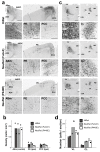Retrograde Transgene Expression via Neuron-Specific Lentiviral Vector Depends on Both Species and Input Projections
- PMID: 34372593
- PMCID: PMC8310113
- DOI: 10.3390/v13071387
Retrograde Transgene Expression via Neuron-Specific Lentiviral Vector Depends on Both Species and Input Projections
Abstract
For achieving retrograde gene transfer, we have so far developed two types of lentiviral vectors pseudotyped with fusion envelope glycoprotein, termed HiRet vector and NeuRet vector, consisting of distinct combinations of rabies virus and vesicular stomatitis virus glycoproteins. In the present study, we compared the patterns of retrograde transgene expression for the HiRet vs. NeuRet vectors by testing the cortical input system. These vectors were injected into the motor cortex in rats, marmosets, and macaques, and the distributions of retrograde labels were investigated in the cortex and thalamus. Our histological analysis revealed that the NeuRet vector generally exhibits a higher efficiency of retrograde gene transfer than the HiRet vector, though its capacity of retrograde transgene expression in the macaque brain is unexpectedly low, especially in terms of the intracortical connections, as compared to the rat and marmoset brains. It was also demonstrated that the NeuRet but not the HiRet vector displays sufficiently high neuron specificity and causes no marked inflammatory/immune responses at the vector injection sites in the primate (marmoset and macaque) brains. The present results indicate that the retrograde transgene efficiency of the NeuRet vector varies depending not only on the species but also on the input projections.
Keywords: cerebral cortex; inflammation; lentiviral vector; neuron specificity; primates; pseudotyping; retrograde gene transfer; thalamus.
Conflict of interest statement
The authors declare no conflict of interest.
Figures






References
-
- Mazarakis N.D., Azzouz M., Rohll J.B., Ellard F.M., Wilkes F.J., Olsen A.L., Carter E.E., Barber R.D., Baban D.F., Kingsman S.M., et al. Rabies Virus Glycoprotein Pseudotyping of Lentiviral Vectors Enables Retrograde Axonal Transport and Access to the Nervous System after Peripheral Delivery. Hum. Mol. Genet. 2001;10:2109–2121. doi: 10.1093/hmg/10.19.2109. - DOI - PubMed
Publication types
MeSH terms
Substances
LinkOut - more resources
Full Text Sources
Research Materials

